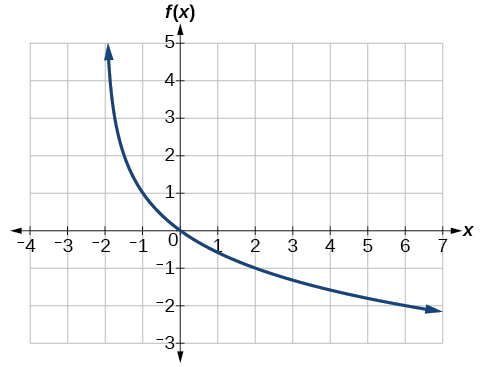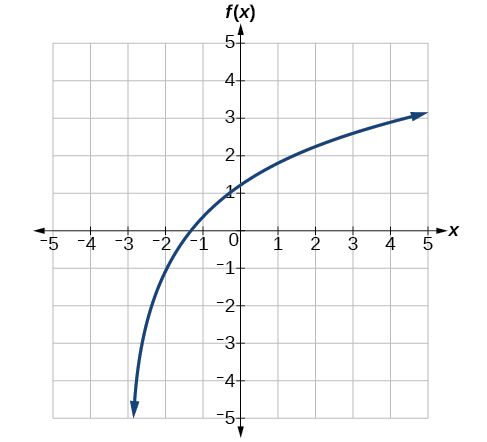Home
College algebra Exponential and logarithmic Graphs of logarithmic functions
Translations of the Parent Function
y
=
log
b
(
x
)
Translation
Form
Shift
Horizontally
c
units to the left
Vertically
d
units up
y
=
log
b
(
x
+
c
)
+
d
Stretch and Compress
Stretch if
|
a
|
>
1
Compression if
|
a
|
<
1
y
=
a
log
b
(
x
)
Reflect about the
x -axis
y
=
−
log
b
(
x
)
Reflect about the
y -axis
y
=
log
b
(
−
x
)
General equation for all translations
y
=
a
log
b
(
x
+
c
)
+
d
A General Note
Translations of logarithmic functions
All translations of the parent logarithmic function,
y
=
log
b
(
x
)
, have the form
f
(
x
)
=
a
log
b
(
x
+
c
)
+
d
where the parent function,
y
=
log
b
(
x
)
,
b
>
1
, is
shifted vertically up
d
units.
shifted horizontally to the left
c
units.
stretched vertically by a factor of
|
a
|
if
|
a
|
>
0.
compressed vertically by a factor of
|
a
|
if
0
<
|
a
|
<
1.
reflected about the
x- axis when
a
<
0.
For
f
(
x
)
=
log
(
−
x
)
, the graph of the parent function is reflected about the
y -axis.
Finding the equation from a graph
Find a possible equation for the common logarithmic function graphed in
[link] .
This graph has a vertical asymptote at
x
=
–2
and has been vertically reflected. We do not know yet the vertical shift or the vertical stretch. We know so far that the equation will have form:
f
(
x
)
=
−
a
log
(
x
+
2
)
+
k
It appears the graph passes through the points
(
–1
,
1
)
and
(
2
,
–1
)
.
Substituting
(
–1
,
1
)
,
1
=
−
a
log
(
−1
+
2
)
+
k
Substitute
(
−1
,
1
)
.
1
=
−
a
log
(
1
)
+
k
Arithmetic
.
1
=
k
log(1)
=
0.
Next, substituting in
(
2
,
–1
) ,
−
1
=
−
a
log
(
2
+
2
)
+
1
Plug in
(
2
,
−1
)
.
−
2
=
−
a
log
(
4
)
Arithmetic
.
a
=
2
log
(
4
)
Solve for
a
.
This gives us the equation
f
(
x
)
=
–
2
log
(
4
)
log
(
x
+
2
)
+
1.
Got questions? Get instant answers now! Got questions? Get instant answers now!
Q&A
Is it possible to tell the domain and range and describe the end behavior of a function just by looking at the graph?
Yes, if we know the function is a general logarithmic function. For example, look at the graph in
[link] . The graph approaches
x
=
−3
(or thereabouts) more and more closely, so
x
=
−3
is, or is very close to, the vertical asymptote. It approaches from the right, so the domain is all points to the right,
{
x
|
x
>
−3
}
.
The range, as with all general logarithmic functions, is all real numbers. And we can see the end behavior because the graph goes down as it goes left and up as it goes right. The end behavior is that as
x
→
−
3
+
,
f
(
x
)
→
−
∞
and as
x
→
∞
,
f
(
x
)
→
∞
.
Key equations
General Form for the Translation of the Parent Logarithmic Function
f
(
x
)
=
log
b
(
x
)
f
(
x
)
=
a
log
b
(
x
+
c
)
+
d
Key concepts
To find the domain of a logarithmic function, set up an inequality showing the argument greater than zero, and solve for
x
.
See
[link] and
[link]
The graph of the parent function
f
(
x
)
=
log
b
(
x
)
has an
x- intercept at
(
1
,
0
)
, domain
(
0
,
∞
)
, range
(
−
∞
,
∞
)
, vertical asymptote
x
=
0
, and
if
b
>
1
, the function is increasing.
if
0
<
b
<
1
, the function is decreasing. See
[link] .
The equation
f
(
x
)
=
log
b
(
x
+
c
)
shifts the parent function
y
=
log
b
(
x
)
horizontally
left
c
units if
c
>
0.
right
c
units if
c
<
0. See
[link] .
The equation
f
(
x
)
=
log
b
(
x
)
+
d
shifts the parent function
y
=
log
b
(
x
)
vertically
up
d
units if
d
>
0.
down
d
units if
d
<
0. See
[link] .
For any constant
a
>
0
, the equation
f
(
x
)
=
a
log
b
(
x
)
stretches the parent function
y
=
log
b
(
x
)
vertically by a factor of
a
if
|
a
|
>
1.
compresses the parent function
y
=
log
b
(
x
)
vertically by a factor of
a
if
|
a
|
<
1. See
[link] and
[link] .
When the parent function
y
=
log
b
(
x
)
is multiplied by
−
1
, the result is a reflection about the
x -axis. When the input is multiplied by
−
1
, the result is a reflection about the
y -axis.
The equation
f
(
x
)
=
−
log
b
(
x
)
represents a reflection of the parent function about the
x- axis.
The equation
f
(
x
)
=
log
b
(
−
x
)
represents a reflection of the parent function about the
y- axis. See
[link] .
A graphing calculator may be used to approximate solutions to some logarithmic equations See
[link] .
All translations of the logarithmic function can be summarized by the general equation
f
(
x
)
=
a
log
b
(
x
+
c
)
+
d
.
See
[link] .
Given an equation with the general form
f
(
x
)
=
a
log
b
(
x
+
c
)
+
d
, we can identify the vertical asymptote
x
=
−
c
for the transformation. See
[link] .
Using the general equation
f
(
x
)
=
a
log
b
(
x
+
c
)
+
d
, we can write the equation of a logarithmic function given its graph. See
[link] .
Questions & Answers
the study of the heat energy which is associated with chemical reactions
Kaddija
How was CH4 and o2 was able to produce (Co2)and (H2o
First twenty elements with their valences
what is the best way to define periodic table for jamb
what is the change of matter from one state to another
what is isolation of organic compounds
Read Chapter 6, section 5
Dr
Read Chapter 6, section 5
Kareem
Atomic radius is the radius of the atom and is also called the orbital radius
Kareem
atomic radius is the distance between the nucleus of an atom and its valence shell
Amos
Read Chapter 6, section 5
paulino
Bohr's model of the theory atom
when a gas is compressed why it becomes hot?
ATOMIC
It has no oxygen then
Goldyei
read the chapter on thermochemistry...the sections on "PV" work and the First Law of Thermodynamics should help..
Dr
Which element react with water
an increase in the pressure of a gas results in the decrease of its
definition of the periodic table
what were atoms composed of?
what is chemistry
Damilola
Got questions? Join the online conversation and get instant answers!
Source:
OpenStax, College algebra. OpenStax CNX. Feb 06, 2015 Download for free at https://legacy.cnx.org/content/col11759/1.3
Google Play and the Google Play logo are trademarks of Google Inc.


